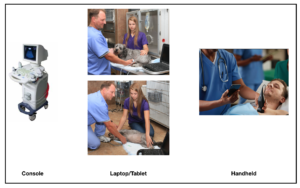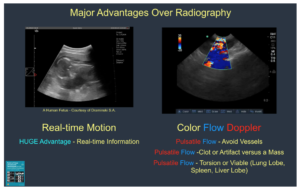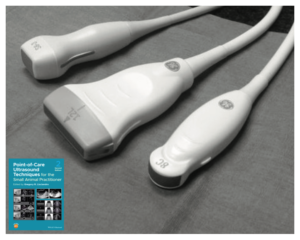This question gets asked a lot and it is more complex than one would think at first glance. So let’s break this down into some categories to make sense of the process.
Keep in mind that with most newer machines the quality of the image is less variable than what it used to be for imaging free fluid (ascites, and retroperitoneal, pleural and pericardial effusion) and obvious soft tissue abnormalities, the objectives of Global FAST®- AFAST®, TFAST®, and Vet BLUE®. Older machines say after 2015 image quite well. Demo the machine if possible.

A. Format:
- Laptop/Tablet – Advantages: portable, can be moved to the patient, both hands free
Disadvantages: more risk for dropping the machine, probe; traditionally less features, less image quality than a console
- Console – Advantages: less risk for dropping the machine, probe; traditionally more features, better image quality than a console
Disadvantages: cumbersome, difficult to move to the patient
- Handheld – Advantages: portable, can be moved to the patient, stored in your pocket
Disadvantages: small screen makes it harder to see the image, more risk for dropping the machine, probe; traditionally less features, less image quality than a console; takes away the non-probe hand from palpating the patient, bracing/stabilizing the probe (when the screen is held in the non-probe hand) – this is very IMPORTANT and not considered by many purchasing these devices. Final note: A curvilinear or microconvex probe (curved surface) is much better than a flattened probe head for probe footprint to skin contact and for rocking the probe especially for the novice.
B. Major Features:
B-mode is your standard real-time, blacks, whites, and grays
Color Flow Doppler allows you to detect flow, specifically, pulsatile flow, which is advantageous for avoiding vessels during ultrasound-guided procedures, for differentiating artifacts and thrombi (clots) from masses, for differentiating a torsion from a viable organ (spleen, testicle, lung, liver), and for differentiating biliary tract, ureters and cysts from vessels.
Ability to Store Prospective Image Captures (Cine Clips) because saving cine (video) clips is helpful for reviewing patient findings and for learning and comparing to future studies, and telemedicine submissions (generally 6-10 second clips of each respective Global FAST® view)
Battery how long does it reliably hold its charge? Some handheld ultrasound machines have batteries that don’t last very long requiring you to purchase 2 batteries so you have one charging while using the other. And some laptop ultrasound machines are problematic as well. The best is to look up reviews on their battery reliability, ask colleagues that have the machines you are interested in, and the salesperson. In fact, if you are very mobile with your use of ultrasound, you may need an extra battery so that you have a charged back-up
C. Probe Type and Frequency (MHz)
Microconvex (also called Curvilinear) Probe with a frequency range of 5-10MHz (or 6-10, or 6-9) is acceptable for the entire Global FAST® Approach and its objectives.
Other probe types would be considered “add-ons” are the Macroconvex (also called Curvilinear) Probe (larger version of the Microconvex Curvilinear Probe), Phased-array (also called Sector) Probe for echocardiography, and Linear for the fine detail of structures such as abdominal organs in small patients (cat-sized or smaller including exotic companion mammals, birds, and reptiles), eyes, musculoskeletal structures like vessels, nerves, tendons and ligaments, and lung surface.
The Microconvex (also called Curvilinear) Probe is the BEST all around probe to have; and it may adequately image smaller patients and abdominal and cardiac structures (cat-sized or smaller including exotic companion mammals, birds, and reptiles), and eyes, musculoskeletal structures like vessels, nerves, tendons, and ligaments. Having additional probes may be more of a luxury than a necessity for many newer machines.
D. Service Policy
Make sure you have a plan to service your machine AND if possible an agreement to have a loaner while the machine is being serviced. There is nothing more frustrating than having your ultrasound machine serviced for 4-6 weeks with no ultrasound machine (or have a back-up machine that may replace the machine being serviced). Check your insurance policy to make sure your machine and probe are covered. A new probe often costs several thousand dollars.
E. Final Notes
When looking at images in textbooks, or presentations, check the screen marker, and the screen for any identifying features as to the manufacturer. Most manufacturers identify themselves in name of by the logo on the ultrasound machine’s screen.
Updated gl/GL 2-24-2023





